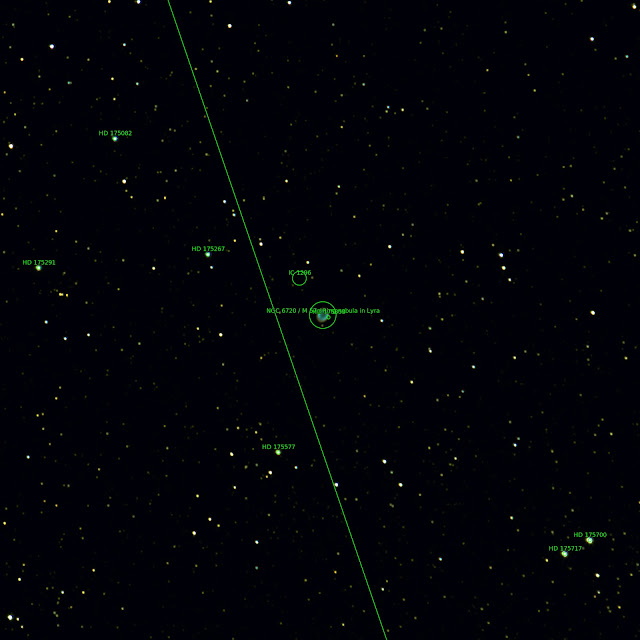Night from 16 to 17 of June was almost clear. Humidity was extremely high, lens became steamed up quickly so I used a hairdryer to warm it up. Near midnight stars had been dimmed by a haze.
This was the second test of my new EQ-5 mount with motor drives. It was used as a sky-tracker which holds Canon EOS 600D DSLR.
I chose M57 nebula for test capture. I made 40 light frames in total with exposure of 30 sec each (qDSLRdashboard Android application was used to control the camera). Canon EF-S F/4-5.6 55-250mm IS II lens was used at 250mm focal length and F/7 stop (to reduce optical aberrations).
Frames were averaged with DeepSkyStacker (using 15 dark frames, 15 offset frames, and 16 flats). Darks and offsets were captured right after the main session, flats were captured next morning.
The result (1x1 arcdegree crop) is shown below, 4x zoomed part is in the inset.
Ring Nebula (Messier 57) is a planetary nebula: a gas shell ejected by a star at the end of its active life. A size of the nebula is about a light year, an estimated distance to it is ~2300 light years. The nebula glows because a star's remnant (white dwarf) in the center of it ionizes atoms which compose the expanding shell. A blue-green color of inner parts of the nebula caused by an emission of double-ionized oxygen, reddish color of outer layers caused by hydrogen and ionized nitrogen emission lines.
Annotated image (by nova.astrometry.net):
This was the second test of my new EQ-5 mount with motor drives. It was used as a sky-tracker which holds Canon EOS 600D DSLR.
I chose M57 nebula for test capture. I made 40 light frames in total with exposure of 30 sec each (qDSLRdashboard Android application was used to control the camera). Canon EF-S F/4-5.6 55-250mm IS II lens was used at 250mm focal length and F/7 stop (to reduce optical aberrations).
Frames were averaged with DeepSkyStacker (using 15 dark frames, 15 offset frames, and 16 flats). Darks and offsets were captured right after the main session, flats were captured next morning.
The result (1x1 arcdegree crop) is shown below, 4x zoomed part is in the inset.
Ring Nebula (Messier 57) is a planetary nebula: a gas shell ejected by a star at the end of its active life. A size of the nebula is about a light year, an estimated distance to it is ~2300 light years. The nebula glows because a star's remnant (white dwarf) in the center of it ionizes atoms which compose the expanding shell. A blue-green color of inner parts of the nebula caused by an emission of double-ionized oxygen, reddish color of outer layers caused by hydrogen and ionized nitrogen emission lines.
Annotated image (by nova.astrometry.net):
Size 1x1 degree


No comments:
Post a Comment